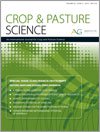Subterranean clover (Trifolium subterraneum L.) is the most widely sown annual pasture legume species in southern Australia, valued in the livestock and grains industries as a source of high-quality forage and for its ability to fix atmospheric nitrogen. From its initial accidental introduction into Australia in the 19th Century and subsequent commercialisation in the early 1900s, 45 cultivars have been registered in Australia. These consist of 32 cultivars of ssp. subterraneum, eight of ssp. yanninicum, and five of ssp. brachycalycinum and range in flowering time from 77 to 163 days from sowing, enabling the species to be grown in a diversity of rainfall environments, soil types, and farming systems. Eleven of these cultivars are introductions from the Mediterranean region, 15 are naturalised strains collected in Australia, 18 are the products of crossbreeding, and one is derived from mutagenesis. Cultivars developed in Italy have been commercialised for the local market, whereas other cultivars developed in Spain, Portugal, and France have not had commercial seed production. Important traits exploited include: (i) selection for low levels of the oestrogenic isoflavone formononetin, which causes reduced ewe fertility; (ii) increased levels of dormancy imposed by seed-coat impermeability (hard seeds) for cultivars aimed at crop rotations or unreliable rainfall environments; (iii) strong burr-burial ability to maximise seed production; (iv) resistance to important disease pathogens for cultivars aimed at medium- and high-rainfall environments, particularly to Kabatiella caulivora and root rot pathogens; (v) resistance to pests, particularly redlegged earth mites; and (vi) selection for unique leaf markings and other morphological traits (where possible) to aid cultivar identification. Cultivar development has been aided by a large genetic resource of ∼10 000 accessions, assembled from its centre of origin in the Mediterranean Basin, West Asia, and the Atlantic coast of Western Europe, in addition to naturalised strains collected in Australia. The development of a core collection of 97 accessions, representing almost 80% of the genetic diversity of the species, and a genetic map, provides a platform for development of future cultivars with new traits to benefit the livestock and grains industries. New traits being examined include increased phosphorous-use efficiency and reduced methane emissions from grazing ruminant livestock. Economic analyses indicate that future trait development should focus on traits contributing to increased persistence and autumn–winter productivity, while other potential traits include increased nutritive value (particularly of senesced material), increased N2 fixation ability, and tolerance to cheap herbicides. Beneficial compounds for animal and human health may also be present within the species for exploitation.
How to translate text using browser tools
13 August 2013
Genetic improvement of subterranean clover (Trifolium subterraneum L.). 1. Germplasm, traits and future prospects
P. G. H. Nichols,
K. J. Foster,
E. Piano,
L. Pecetti,
P. Kaur,
K. Ghamkhar,
W. J. Collins
ACCESS THE FULL ARTICLE

Crop and Pasture Science
Vol. 64 • No. 4
Aug 2013
Vol. 64 • No. 4
Aug 2013
annual pasture legumes, cultivars, genetic resources, plant breeding, traits.




